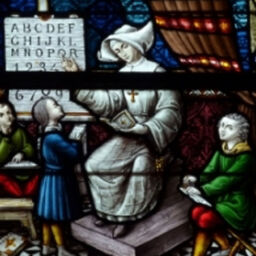
Honey, I J’d the Cat
Sophia Dunn, January 7, 2015
 Type is an essential piece of our family life. It not only helps us to understand and support each other, it helps us to allocate chores and tasks, prevent and resolve conflict, choose presents, decide times and locations for family holidays, and develop a shared understanding of the social world we inhabit.
Type is an essential piece of our family life. It not only helps us to understand and support each other, it helps us to allocate chores and tasks, prevent and resolve conflict, choose presents, decide times and locations for family holidays, and develop a shared understanding of the social world we inhabit.
We are a reconstructed family. My husband Mark (INTJ) and I got together thirteen years ago as divorcees. To our new marriage, I brought my then 5-year-old son, Benedict (later discovered to enjoy INFJ preferences), together with something unexpected and at first somewhat unwelcome: a well-developed obsession with the MBTI®.
I was obsessed (and continue to be), as only an INTP can be obsessed. My husband, being among the most skeptical of all types, resolutely refused to consider taking the Indicator, and so for a few years I was kept guessing, and my obsession remained in the background of family life.
When he finally agreed, it was a shared work concern that clinched it. Both Mark and I are clinical psychotherapists and run a psychotherapy clinic together. At the time, we had just landed a lucrative civil contract with the London Metropolitan Police Service, and Mark was asked to provide most of the therapy. While it was a major boon for our livelihood, I was concerned about how Mark would fare providing therapy to police personnel. I’d read Thinking Cop, Feeling Cop: A Study in Police Personalities (Hennessy, 1998) and although I was not terribly concerned about Mark’s ability to negotiate different judging functions, I was very concerned about how the dominant Sensing preference of most police people would play out in the work. Typically, S-preferenced people are less likely to seek therapy, and even less likely to complete a course of therapy (Bryden, 2005). I’ve always suspected that the reason for this is that most therapists have a preference for Intuition and this is reflected in their style of therapy.
While I could (and did) speculate on his other functions, I was absolutely certain my husband was not S-preferenced. I foresaw the possibility of boredom, frustration, confusion—even failure—on the horizon. Everyone has seen on television how members of the police force typically react to ‘counseling.’ For myself, I grew up in a family heavily populated with police and military personnel. I was only too familiar with the theme, and knew my concerns were not misplaced. I explained the issue well enough that Mark was intrigued and I left him with Hennessy’s book.
Two days later, he asked if I would take him through the MBTI.
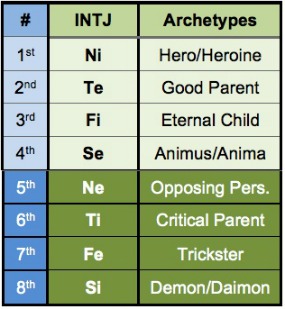 It seemed a victory of sorts, but the difficulties were far from over. Almost all of the Myers-Briggs instrument’s questions elicited a barrage of challenges. As his frustration grew, so did mine. “Look,” I said finally, “the questionnaire is not trying to sort for anything you might possibly do in a given situation. It’s trying to give you an understanding of what you mostly prefer.” I did the handedness exercise. “Yes, sure, you use your left hand for all sorts of things, but generally, you prefer to use your right hand. That’s what it’s trying to sort. Don’t worry about what you do when you’re stressed, in a coma, or have just returned from Neptune with a load of baboons. What would you do if you were pleasantly but thoroughly tired and no one was watching?”
It seemed a victory of sorts, but the difficulties were far from over. Almost all of the Myers-Briggs instrument’s questions elicited a barrage of challenges. As his frustration grew, so did mine. “Look,” I said finally, “the questionnaire is not trying to sort for anything you might possibly do in a given situation. It’s trying to give you an understanding of what you mostly prefer.” I did the handedness exercise. “Yes, sure, you use your left hand for all sorts of things, but generally, you prefer to use your right hand. That’s what it’s trying to sort. Don’t worry about what you do when you’re stressed, in a coma, or have just returned from Neptune with a load of baboons. What would you do if you were pleasantly but thoroughly tired and no one was watching?”
Finally, I got a completed form M. And to this day, when someone delivers a similar barrage of challenges in response to completing the inventory, I suspect INTJ. I’m often right.
Mark’s preferences were very clear, and things really changed when he read his profile. I could see him shaking his head in amazement. “Can I read yours,” he asked, “just to make sure it’s not like a horoscope?” He was even more amazed: “This is you!” I recall a wonderful, tender moment of recognition between us.
“But could it also be you?” I returned, addressing his skepticism.
“Definitely not.”
I drew him an eight function-attitude line-up and explained his top four functions and how they worked together. He was hooked and close to tears. “Nobody has ever got that about me,” he said, referring to his dominant introverted intuition (Ni).
What followed was the first of many wonderful evenings, with lots of wine and introverted excitement, discussing type into the wee hours. It was the beginning of a wealth of understanding that would support and inform our marriage, our work, our life together for the next decade and beyond.
I helped Mark learn to ‘speak Sensing’ and to tailor his therapeutic offering to what was to be a steady two-year stream of troubled and traumatized police. He learned to be very concrete, to offer practical suggestions that would result in immediate change and relief, ‘hooking them into’ the process. He worked hard to use only simple metaphors, not to over-speculate, never to use jargon or indulge in existential meanderings. He learned not to challenge protocol or tradition (difficult for an INTJ), and learned why doing so would cause rupture. With few exceptions, his cops both liked and trusted Mark and the results were excellent, as measured not only anecdotally but through administration of before-and-after inventories that quantified depression, anxiety, and personality disturbance.
I had a convert. “Make It Work” seems the INTJ motto, and for Mark, type worked. It had earned its place in his toolbox.
That first major success also brought type ‘home’ for us. It became a language of understanding and tolerance—a way of exploring difference—a language of intimate curiosity for both of us. We learned that while our four-letter types seemed similar, we were actually vitally different.
The eight-function model helped us to understand just how profound our differences were. It was easy to see that while our type codes showed our personalities as broadly similar, the function-attitude model revealed the fundamental differences. We shared not one function in our conscious line-up. We explored judging differences: ‘Make It Work’ (extraverted thinking) vs. ‘Understand How It Works’ (introverted thinking); and perceiving differences: ‘What does this pattern tell me about the world?’ (extraverted intuition) vs. ‘What is the personal meaning of this?’ (introverted intuition). And that was just the beginning; we’re still exploring.
Mark trained in the MBTI, and joined me in the work of exploring its use, both at work and at home. At the beginning of our marriage, we had two divorces to negotiate, one extremely acrimonious. We moved three times in two years, and completed a major house renovation. Mark changed jobs, leaving a senior Health Service post he had occupied for over twenty years to join me full time in my little private practice. I was diagnosed with a chronic autoimmune disease and we had to learn how to accommodate this new demanding presence in our shared lives. We were further challenged when one of us was stalked by the spouse of an ex-patient. It was all simultaneous. In those first three years, we were challenged by life events any one of which might rupture a family, and type was part of the glue that held us together.
Mark came home one afternoon to find me sobbing uncontrollably, pots and pans all over the kitchen floor. I had had what might only be described as a tantrum. He comforted and soothed me, but I knew he was alarmed at my sudden violent outburst. I felt stupid, childish, and sheepish. When I was more or less calm and recovered, we worked at trying to understand what had happened. “It’s always been the same,” I said. “I’m fine, fine, fine in a crisis—reasonable, clear-thinking, and useful—until suddenly I’m not. It’s as if I don’t know what I really feel, deep down, until it overwhelms me. It’s a real disability. It’s as if I get no warning.”
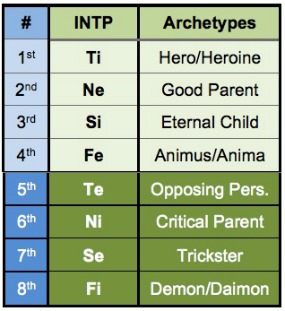 Together we sought understanding from my eight-function line-up. The penny dropped. What had happened was not a 4th function (extraverted feeling, Fe) eruption, but an 8th function (introverted feeling, Fi) eruption, according to the Beebe model. My outburst was not about what I felt others should be doing, what others thought of me, or how they might or might not have transgressed norms or even exiled me. It was an eruption of very primitive, childlike, undeveloped, but nonetheless deeply held Fi. It was an explosive upsurgence of “But what about me?!”
Together we sought understanding from my eight-function line-up. The penny dropped. What had happened was not a 4th function (extraverted feeling, Fe) eruption, but an 8th function (introverted feeling, Fi) eruption, according to the Beebe model. My outburst was not about what I felt others should be doing, what others thought of me, or how they might or might not have transgressed norms or even exiled me. It was an eruption of very primitive, childlike, undeveloped, but nonetheless deeply held Fi. It was an explosive upsurgence of “But what about me?!”
Indeed, in navigating all our crises on many different fronts, I had neglected my own needs, not out of martyrdom, but simply because I was unaware of them. With tertiary Fi, Mark was so much better at this brand of self responsibility than I was. Without type, the incident might have ended at the comfort stage, without further understanding. It might even have ended before the comfort; he might have judged me immature and volatile. The net result could easily have been increased wariness on his part, guilt and isolation on mine. Instead, it was one of many incidents involving different functions and sparks that brought us closer in compassion, appreciation, and gratitude.
Type provided a structure, a map, a way of understanding issues that were deeply personal, and often elusive.
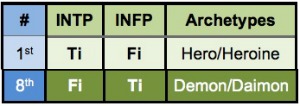 How events affected our children was a minefield of potential misunderstanding. Mark’s adolescent daughter (INFP) remained living with her mother. She struggled with understandable feelings of abandonment and betrayal. But with her dominant function my 8th function, and vice versa, she and I continually sparked each other. As the adult, it was up to me to be the elastic in the situation, and I did my best. While my best was often insufficient, I know it was better than it might have been without type understanding.
How events affected our children was a minefield of potential misunderstanding. Mark’s adolescent daughter (INFP) remained living with her mother. She struggled with understandable feelings of abandonment and betrayal. But with her dominant function my 8th function, and vice versa, she and I continually sparked each other. As the adult, it was up to me to be the elastic in the situation, and I did my best. While my best was often insufficient, I know it was better than it might have been without type understanding.
Type also helped Mark and my son in their new relationship. Even though only five at the time, Benedict’s INFJ preferences were already very clear, and I know it was helpful for Mark to understand how hard it was for Benedict to be in the middle of a divorce. Divorce separated him from his peers. Just the difference between his name and his parents’ names made him feel unpleasantly different and ‘misfit.’ What others thought (and there was plenty of moral judgment swirling around us) really mattered to my son. While community ‘judgment’ was a matter of angry rebellion for Mark, it was cringe-worthy and exiling for Benedict.
And Benedict was at a real disadvantage, type-wise. He was a beleaguered extraverted feeling (Fe) type in a very thinking-intensive world, with four T-preferenced parents: His father has ENTJ preferences and his stepmother, ISTP.
Understanding how differently our F-preferenced children might encounter family upheaval has been vital to our present equilibrium. We knew that we were prone to misunderstanding our kids in difficult and volatile situations. At the very least, it gave us pause. We did our best to reflect on their judging differences whenever we took action that affected them, and most importantly, whenever we explained the changing situations to them.
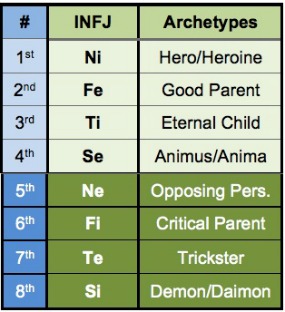 Benedict was so keen to please, so eager to do what was considered ‘right;’ he never wanted to make a mistake or do anything that wasn’t OK in everyone’s eyes. He didn’t want to stand out; he cared deeply about what others thought of him, and very clearly wanted those around him to be in harmony. This is not a typically ‘T’ way of being; harmony was not our greatest priority. The situation we were in would not be harmonious for quite a while; we knew that, and accepted it in a way that our children could not. Had we not understood type, Mark and I might have dismissed our children’s needs as merely childlike rather than vital.
Benedict was so keen to please, so eager to do what was considered ‘right;’ he never wanted to make a mistake or do anything that wasn’t OK in everyone’s eyes. He didn’t want to stand out; he cared deeply about what others thought of him, and very clearly wanted those around him to be in harmony. This is not a typically ‘T’ way of being; harmony was not our greatest priority. The situation we were in would not be harmonious for quite a while; we knew that, and accepted it in a way that our children could not. Had we not understood type, Mark and I might have dismissed our children’s needs as merely childlike rather than vital.
It was a very humbling business, working to avoid imposing parental type, and along with it, parental judgments and assumptions. It was also far from easy, nor even always successful. There were bumps and land mines and huge misunderstandings along the way, not least because all differences cannot be understood by type alone. But all of us are clear: it would have been much lonelier and more difficult—for us as a family and for each individual—without the understanding that type provided.
As the dust cleared, the crisis died, and we slipped into gentle family routine, suddenly it was differences in our lifestyle attitudes that created challenge.
Both my son and my husband are Js, and I am a P. By far, this has become the most profound difference for all of us. They are goal oriented; I am process oriented. I remember Benedict once asking me quite mildly, “What’s for dinner, Mum?” while I was cooking. I didn’t know. “Food!” I replied irritably. Typically I don’t always know what the result might be until I am two-thirds of the way through cooking something. I might just start with an onion, and add things until it takes shape. Until recently, I failed to see this as unusual. But Benedict, having gained substantial ‘type-savvy’ from his parents, was far from being put off by my irritable response to a perfectly understandable question (after all, I was cooking dinner). He asked sagely, “Sorry, Mum, am I J-ing you to death?”
In our family ‘to J’ is a commonly used verb. “Who J’d the gaffer tape?” which means, ‘Who put the gaffer tape away somewhere where I can’t find it?’ My J-preferenced housemates need predictable order; I need a multitude of choices always visibly at hand. This means they like surfaces clear and things relatively tidy. I need everything out where I can see it. If it’s put away, it stops existing for me, and I often buy it again. (Why does any family need three sifters?) These two different ways of organizing our worlds cause conflict and drive us a bit nuts sometimes. Understanding type, they more easily put up with my chaos and I do my best not to feel their need for structure as controlling.
We clearly see advantages in the difference. They know they can rely on me to help one of them explore every conceivable angle of something important before they present it or commit to it, whether it is a letter asking for a job or buying a new car. If something needs precision they know I will reliably and patiently provide it. If I need to know how to structure or finish something, I know either one of them can provide valuable help. If I get bogged down in details, I can trust that either Mark or Benedict will help me cut to the chase.
Our tasks aren’t divided up by gender but by type. If it’s detailed and requires patient persistence, endless experiment, or attention to minute detail, I end up with the task. If it’s something that ‘just needs to get done’ well enough and quickly, the chaps tend to take care of it. They do the vacuuming; I dust. They tidy the house in a flash; I ensure the bathrooms are MRSA free, and clean the lime scale with a toothbrush. We admire each other’s strengths and skills.
Don’t ask me to develop a filing system; it will take months. When finally finished it will be the most flexible, detailed filing system in existence, and you’ll never find anything. So Mark does the finances and the household filing; he keeps it all wonderfully ordered in lists and spreadsheets. He hates it; but he does it. I am deeply grateful.
I manage all the digital technology. I keep passwords, hardware, software, websites, DNS and domains, blogs, phones, apps, music, email addresses, passwords, routers and internet providers sorted and working. Unlike Mark or Benedict, who both have introverted sensation (Si) in the 8th position, I can see where the lack of a dot determines whether you do or don’t get your email. Like my husband with the finance, I hate it (I have Si tertiary, a relatively conscious but not very competent position); but I can do it and they can’t. They are both grateful.
Type provides us with a way of understanding why some things are harder for one person to ‘get’ than for another. Its understanding allows us to see these things as differences, like height or strength or eye color, rather than shortcomings. It makes us more patient, more kind. It also allows us to bring humor to bear on our differences.
We laugh at our type peculiarities—my addiction to precision: “Don’t ask her the time; she’ll tell you how her watch works”—Benedict’s need for moral clarity: “Beware the Indignator.” Benedict and I nicknamed Mark, “Bucket” (as in, “of cold water”) because of the regularity of hearing, “That won’t work.” ‘Bucketing’ has become a verb in our household as well, and it doesn’t mean pouring with rain.
Type informs our cooperation, and aids our joined desire to always be able to say ‘yes’ to the world, rather than ‘no.’ Quite simply, it helps us love each other well.
References
Hennessy, S. (1998). Thinking cop, feeling cop: A study in police personalities. Gainesville, FL: CAPT.
Bryden, B. (2005). Sundial: Theoretical relationships between psychological type, talent, and disease. Gainesville, FL: CAPT.
Header Image
Franz Marc, “Zwei Katzen, blau und gelb” (“Two Cats, Blue and Yellow”), (1912). Courtesy: Kunstmuseum Basel.















